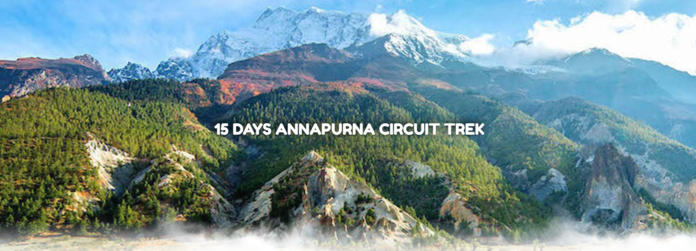The Annapurna Circuit Trek offers MORE than just a stroll through some of Nepal’s most amazing landscapes — it’s an epic journey through a slice of the Himalayan mountain range and the lives of different peoples who have resided in the area for generations. Annapurna Circuit Trekking provides some of the very best trekking in some of the most stunning places on earth, where villages cling to steep hillsides, ancient monasteries of the Himalayas, and where very few people dare to venture. Anyway, you’ve got here to do a Trekking _ Nepal _ Annapurna Circuit trek or even a quick Annapurna Circuit trek. The cultural diversity on this great trail can be one to remember. Here’s how to tap into the rich cultural history of this iconic trekking route.
Ethnic Villages Hike Among the Annapurnas
There isn’t always a day of the Annapurna Circuit trek that you do no longer visit some other ethnic village, and the different ethnic groups have one-of-a-kind cultures, traditions, and living patterns. The villages lie in a diffusion of habitats from subtropical wooded areas to alpine meadows, reflecting the caste mosaic of the location. You start your journey on the Annapurna Circuit at Besishahar, which is the entry point, and from the first footsteps of the walk, you experience the culture of the Gurung in Nepal, especially, who are linked with being warm, welcoming, and have a longstanding history of service in the British Gurkha regiments while in the village.
The more countries you get, the more Tibetan Buddhism there is. In Manang, as in other parts, you sense the complexity, the tension of Tibet and Nepal. Walk among the historical, wooden houses, prayer flags fluttering inside the crisp Himalayan winds, and monasteries, which might be a glimpse into the spirituality of the humans dwelling here. The Annapurna Circuit Trekking path becomes a spectacular chance to visit the villages, and every walk you take is a great lesson in the cultural wealth of these far-flung villages, which have been held in custody for the last many centuries.
Villages like Marpha, where the apple orchards bloom, were an interesting cross between Tibetan and Nepali. Power plugs and sockets are of course the same Stupas and the old Buddhist monasteries are visible on every corner of every street, and the fabric of your life. Hands up if you think when you pass through Marpha, it’s as though you’ve walked back in time, with its white-walled buildings and narrow streets?
The path abounds with nearby humans, their stories, way of life, and manner of life. Whether it’s the simple life of the lower Gurung villages or the extra Tibetan-influenced highlands, there may be a lifestyle at every switch on the Annapurna Circuit.
Sightseeing trip to Buddhist Monasteries and Stupa: Erst while (evening)
The Annapurna Circuit is a walk in the mountains, and it’s a walk in the spirit. Undoubtedly, on the way to the top, beside nature, you could observe several Buddhist monasteries, stupas, as well as different sacred places, lesser significant pilgrim sites local people cling to their beliefs. These are places where trekkers can absorb the spiritual wealth of the Annapurna region and the Himalayas.
Trek Highlight Manang Monastery, hike up nearby hill for views of ranges, including the far view of peaks surrounded by beautiful mountains. This monastery, hundreds of years old, is a sanctuary for the monks, and for trekkers, a place to ease the pain of fatigue and calm the mind for meditation. The monks also have some colourful murals to maintain, which portray the history of Buddha from his birth to other Tibetan gods. The wood carvings culminate at either end, and the barely swaying tintinnabulation of the Buddhist prayers in the background lends timelessness to the still calm.
Muktinath temple for the religious on the spiritually & holy inclined who are new would be visiting Mukthinath temple Rivers It is a combination of two words mukti: liberation, nirvana and nath: god which has a great significance in both Hindu and Buddhist religions the Temple is situated at the foot of the Thorong La mountain pass, 3,800 meters above sea level the site for the temple was believed to be the place where Guru Rinpoche one of the important figures in the Buddhist religion meditated it is also a place considered to be sacred by the Hindu also, the Mukthinath temple is the quintessence of the main 108 Vishnu temples visited by the foreign tourists the flow of the Gandaki River serves as a source of water as the birth place of the River comes in here. The temple is situated at the bottom of Thorong La pass and is said to have the power of a miracle; therefore, people from all over Nepal and India come to visit the temple to pray. Here the holy waters of the temple flow from 108 spouts, and it’s believed a bath in the waters purifies the soult’s only when you KNOW you have faith, are you conscious have or been there to the real “spiritual vibe” above all religion and culture that what you left behind is an ambience, a divine so difficult to replicate.
Participating in Local Festivals
fairs: you can also do a cultural excursion on the Annapurna Circuit whilst hiking and plan your trip so it coincides with one among dozens of galas in the vicinity. Fiestas are a crucial part of life in Annapurna and offer a colourful glimpse into its culture and religion. And should you be lucky enough to visit at some point during Tihar (the competition of lighting fixtures) or Lhosar (Tibetan New 12 months), you’ll see the festive aspect of the city, in which neighbourhoods flood the streets.
Lhosar is most animated in villages with many Tibetans, like Manang and Marpha. This festival of the new year itself is a dance with singing and prayer to the gods for a good harvest of the coming growing season. People from surrounding areas and others from afar who respect the village will take to the streets in a riot of colour, and there is nothing to stop you from joining in and getting into the spirit of the village and their culture and beliefs
Similarly, on the day of Tihar, the Festival of Light in autumn, oil lights, candles, and flowers of darkened hues are burned by families, providing one of the most beautiful sights in the tidy villages. The people here worship animals, Mother Earth, and the harvest, as the natural elements are not the only ones to be worshiped. The sparkling panoramic view of those villages, thousands of lamps, impressive, and you can perceive through this how much culture and religion have been mixed in their daily life.
Connecting with Local People
There are also humbling vistas and holy websites, but what endures most for me on the Annapurna Circuit are the people. The indigenous peoples are Gurung, Magar, and Tibetan. The locals had been very pleasant and beneficial. Whether or not it’s napping in a teahouse or eating with a nearby family, the pleasure of hiking is traveling with these groups.
Appearances The Gurung of the lower villages have a culture remarkably distinct from that of the Gurung above; architecture which is not Gurung kalo houses (see elsewhere) to be seen, so is the architecture elsewhere, such as the music and the food. Higher up in the upper regions (e.g, Manan), you WILL see authentic Tibetan culture & customs with the men in traditional dress and the language spoken being some form of Tibetan. These are glimpses of a rarefied life here, but one that has largely stayed the same for hundreds of years.
You sleep in local teahouses (it’s a B&B for trekkers!) as Annapurna Circuit Trekking Nepal, spend the time, and dip into different cultures of people. You can congregate in the fire’s proximity and tell stories and eat Nepali staple meals like dal bhat or momo, over which you can listen to stories of triumphs and travails of life in the deep mountains. There is certainly no better way to experience the cultural complexity of the Annapurna district than engaging with its residents.
Conclusion
( All the Porter has to do is throw it upon the paçatelle, carry, and never take anything for it ). Annapurna Circuit Trek is a test — not only of stamina, but also of determination. And, in the end, your patience — or just plain stubbornness in the face of adversity. En route, trekkers will get to soak up the ancient monastery’s generous hospitality of the locals and the good nature of the villagers, as the Annapurna Circuit offers the chance to experience the history, culture, and spirituality that are so deeply rooted in this area. Contact with the local people and culture of the Annapurna circuit, and it is only up to your memory to keep and pass on the race through all things done, and men have the right to the Annapurna Circuit in Nepal.

